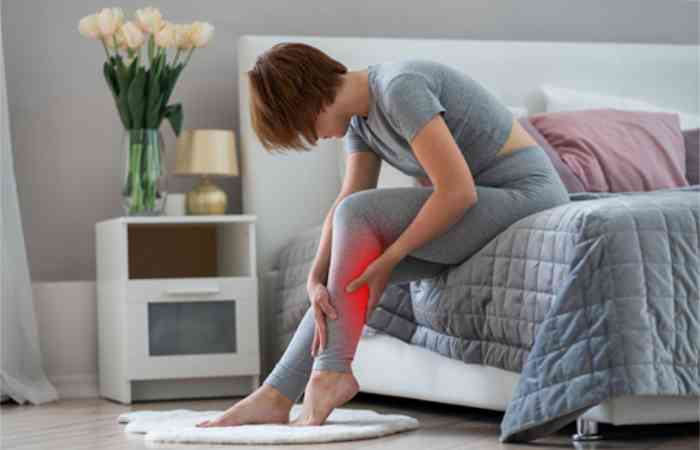Muscle soreness is a common experience after physical activity, especially if it’s more intense or different than what you’re used to. This feeling, called delayed onset muscle soreness (DOMS), can peak a day or two after exercise or from activities like gardening or moving furniture. If you need help relieving this discomfort, this guide will explore various ways to alleviate sore muscles so you can continue your active lifestyle.
Table of Contents
1. Rest and Sleep
Rest plays a crucial role in the muscle recovery process, offering your body the chance to repair and rejuvenate after physical activity. Sleep quality directly influences how effectively your muscles recover, and one of the key factors in this equation is your mattress.
Opting for a high-quality mattress, especially a firm mattress, can make a significant difference. A firm mattress provides the necessary support to align your spine and relieve pressure points, facilitating deeper, more restorative sleep. This design helps recover your sore muscles, ensuring you wake up refreshed and ready to tackle the day. When selecting a mattress, consider a queen size mattress for its ample space and comfort, and ensure it ranks among the best mattresses in terms of support and durability.
2. Proper Warmup and Cooldown
A proper warmup and cooldown routine is an essential part of any fitness regimen. Warming up helps prepare your body for physical stress by gradually increasing heart rate and circulation, which helps loosen joints, increase blood flow to the muscles, reduce the risk of injury, and facilitate better performance.
On the other hand, cooling allows your body to gradually return to its normal state, reducing the risk of dizziness or fainting. It also removes lactic acid, a by-product of exercise that can cause muscle soreness. Consider incorporating simple exercises like neck rolls, shoulder shrugs, side bends, arm circles, hip circles, and gentle forward and backward bends into your warmup and cooldown routine.
3. Hydration
Water aids in transporting nutrients to the muscles, supporting their repair and growth. Conversely, dehydration can lead to muscle cramps and reduced performance. To stay adequately hydrated, drink plenty of fluids throughout the day, not just when you’re thirsty. Carrying a water bottle with you is an easy way to ensure hydration. Drinking water before, during, and after exercise is also essential to replace the fluids lost through sweat.
4. Active Recovery
Active recovery refers to engaging in low-intensity physical activity to help the body recover from strenuous exercise. It enhances blood circulation, which aids in transporting nutrients to the muscles and removing waste products. Therefore, it facilitates quicker muscle recovery. Examples of active recovery activities include walking, cycling at a slow pace, and doing yoga. These low-intensity exercises help keep your body moving without putting too much strain on your muscles, making them perfect for recovery days.
5. Cold Therapy
Cold therapy, such as ice packs or cold baths, can help reduce inflammation and muscle soreness after intense exercise. The cold helps constrict blood vessels, helping reduce swelling and numb pain. However, it’s important to use cold therapy safely. Never apply ice directly to the skin. Instead, wrap it in a thin cloth to avoid frostbite. Application should last for about 15-20 minutes, with at least an hour break between applications. Always listen to your body and stop if you’re feeling uncomfortable.
6. Heat Therapy
Heat therapy can be an effective way to relax tight muscles and relieve soreness. The warmth helps to increase blood flow, which aids in muscle relaxation and promotes healing. Methods of heat therapy include warm baths, heating pads, or saunas. A warm bath can soothe stiff, aching muscles, while a heating pad can target specific problem areas. Saunas, meanwhile, can provide overall muscle relaxation. Always remember to stay hydrated when using heat therapy and never apply heat directly to the skin.
7. Nutrition
Proper nutrition is key for muscle recovery. Consuming protein-rich foods like lean meats, dairy, and legumes can help repair and build muscle tissue. Potassium in foods like bananas and sweet potatoes can prevent muscle cramps and speed up recovery. Magnesium, abundant in nuts, seeds, and whole grains, aids muscle relaxation and reduces soreness.
Simple dietary changes can make a big difference. Try incorporating a protein shake or a banana into your post-workout routine. A balanced meal with a good mix of proteins, carbohydrates, and healthy fats within two hours after a workout can also enhance muscle recovery. Everyone’s dietary needs are unique, so it’s important to tailor these suggestions to your needs and goals.
8. Massage
Massage therapy is a great way to soothe sore muscles. It increases blood flow to the muscles, which helps speed up recovery. Additionally, it helps break up knots and reduce muscle tension. Self-massage tools like foam rollers, massage balls, or handheld massagers can be very beneficial. They allow you to apply targeted pressure to your muscles, helping to alleviate tightness and pain. Always listen to your body when using these tools, and don’t apply too much pressure, as it could cause injury. If your pain is chronic or severe, consult with a professional massage therapist.
9. Professional Help
If muscle soreness persists despite home remedies, or if it’s accompanied by severe pain, swelling, or inability to move, it may be time to seek professional help. Physical therapists and medical professionals can assess your condition, provide targeted treatment plans, and guide you on appropriate exercises to aid recovery. They can also rule out serious injuries. Their expert advice and intervention can be invaluable in not just relieving pain, but also in preventing future muscle problems.
Conclusion
Whether you’re an athlete or someone who enjoys a regular workout, addressing muscle soreness is crucial for maintaining an active, healthy lifestyle. Everyone is different, and what works for one person might not work for another. Listen to your body and experiment with these techniques to find what works best.

